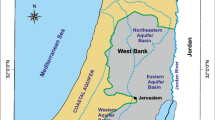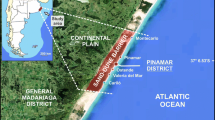Abstract
The aim of this study was to conduct a hydrologic analysis to define the boundaries of the 29 watersheds that make up the study area, as well as physiographic characterization through the estimation of parameters governing their hydrological functioning. The results, in summary, is that the evaporation, evapotranspiration and storage in the unsaturated zone, are linked closely to the functioning of the soil where it is concluded that more than two thirds hasty return of the water to the atmosphere through the three processes described. The estimate of recharge capacity or volume of infiltration was carried out through a methodology whose structure is based on three concepts: location, climate, hydrology and hydrographic aspects of micro, water balance of the Valley of Mexico Basin; and water balance of the Conservation Area.
Access provided by Autonomous University of Puebla. Download chapter PDF
Similar content being viewed by others
Keywords
1 Location, Climate, Hydrology and Hydrographic Aspects of Watersheds in the Protected Zones
1.1 Location Area
Mexico City is located southwest of the Basin of Mexico; it has a total area of 150,156 ha, 59.04 % of the territory, which corresponds to an area with rural characteristics. In this region, agricultural areas and natural ecosystems play an important role in maintaining environmental balance. At an altitude of over 2,240 m.a.s.l, it has four types of climate; and it is characterized by an annual average temperature between 12°C and –18 °C. The rainy season occurs between the months of May to October and the average annual precipitation varies in a range of 600 mm in the northeast, and 1,500 mm in the west.
1.2 Hydrology
The aim of the hydrologic analysis conducted on the surface of the Protected Area was to define the boundaries of the 29 hydrologic units or watersheds from the study area.
In each of the hydrologic units a characterization was made through the estimation of parameters such as: area of the basin hypsometric curve (area distribution as a function of elevation); perimeter of the unit, length of the larger axis, elongation ratio, shape index, total length of channels, stream order and drainage density.
The previous parameters define the hydrological behavior of the watersheds, and the results of the analysis are presented in Fig. 22.1:
1.3 Hydrographic Aspects of Watersheds
The characteristics presented by the micro-basins are fundamental to understand the hydrological functioning. Figure 22.1 shows the delineation of the 29 watersheds: Basin water balance of the Valley of Mexico, Conceptual Model, Estimation of hydrological balance variables.
2 Conceptual Model
The hypothesis used for the water balance is the principle of conservation of mass within the limits established by its watershed. To estimate the water balance of a catchment and to identify the variables involved in this process, the principle of continuity to a control volume that surrounds the main stream was applied, including the eight hydrological variables involved in the balance (Fig. 22.2).
2.1 Estimated Balance Hydrological Variables
With the support of the mean values of hydrological variables recorded during a period of 45 years (1960–2004), the water balance of the Basin of Mexico was estimated. Table 22.1 shows the annual average values of its components in hm3 (million cubic meters) and m3/s (cubic meters/second) and its corresponding percentages (CNA 2007).
Table 22.2 shows the situation of surface water and groundwater. Analyzing the values in Table 22.2 reveals a number of important conclusions related to the use of surface water and groundwater. In the Mexico City Basin, rainfall runoff generated hm3 748 (23.7 m3/s), however, only advantage through rivers and springs a cost of 92 hm3 (2.9 m3/s), i.e. only total runoff uses 12 %.
3 Water Balance Study, Conceptual Model, Estimation of Hydrological Balance Variables
3.1 Conceptual Model
The conceptual model is based on the hydrological processes that occur in the atmosphere, as well as surface and subsurface layers.
In this case, the movements of water in all three phases have a very close relationship, highlighting their behavior in surface and underground layers, as it depends on vegetation cover and the dominant subsoil type. Figure 22.3 illustrates the map of isohyets defined, including the current land use and runoff coefficient values. At a later stage, with the support of Fig. 22.3, it upheld the method of isohyets, the height of average rainfall and the areas between two consecutive isohyets. Derived from the values described above, the volume of rain between isohyets was calculated by multiplying the height of average rainfall for the area between isohyets, and adding the partial values, which gives the total volume of rain that rushes over the test area.
The calculation process is summarized in Table 22.3, which analyzes the results; it appears that on average they fall onto the surface of the study area of 1,674 billion cubic meters per year.
By solving Darcy’s equation for each cell formed by the streamlines, the volume of water traveling was obtained from the upper parts and finally reaching the south and southwest of the basin. The volume of deep percolation or recharge generated was 209 million cubic meters. The soils were highly permeable and exhibit high moisture content and their depths ranged from several tens of centimeters to 2 m. Moreover, as displacing downstream, soil depths are of the order of several tens of meters, showing a great heterogeneity and anisotropy, key features to eliminate these parts as deep recharge (Jacobo 1992, 1993; Jacobo and Morales 1997, 1998). For its part, Table 22.4 shows the results of each of the components involved in the water balance. The results are presented in hm3 (million cubic meters), m3/s (cubic meters/second) and their corresponding percentage.
4 Conclusion
In summary, evaporation, evapotranspiration and storage in the unsaturated zone have joint values of 1.335 billion m3 per year; and according to the average value of 1674 million m3 per year of precipitation, it can be concluded that more than two thirds of precipitation returns to the atmosphere through the processes previously described.
References
CNA, Comisión Nacional del Agua (2007) Equilibrio hidrológico en la Cuenca del Valle de México, México
Jacobo MA (1992) Fenómeno de la condensación de niebla como posible aporte a sistemas acuíferos. XII Congreso Nacional de Hidráulica, México
Jacobo MA (1993) Resultados preliminares de la campaña de medición en la zona de Monte Alegre, en el volcán Ajusco. Instituto de Geofísica – UNAM, México
Jacobo MA, Morales R (1997) Análisis de la captación de agua del suelo en la frontera con un medio fracturado. Primer Congreso Nacional de Aguas Subterráneas, Yucatán
Jacobo MA, Morales R (1998) Determinación de las zonas de recarga en cuencas de montaña. Reunión de Ciencias de la Tierra. UNAM, México
Author information
Authors and Affiliations
Corresponding author
Editor information
Editors and Affiliations
Rights and permissions
Copyright information
© 2013 Springer-Verlag Berlin Heidelberg
About this chapter
Cite this chapter
de León, M.F.N.P., Puyol, A.B. (2013). Aquifer Recharge Capacity in the Protected Area South of the Basin of Mexico. In: Farfán González, H., Corvea Porras, J., de Bustamente Gutiérrez, I., LaMoreaux, J. (eds) Management of Water Resources in Protected Areas. Environmental Earth Sciences. Springer, Berlin, Heidelberg. https://doi.org/10.1007/978-3-642-16330-2_22
Download citation
DOI: https://doi.org/10.1007/978-3-642-16330-2_22
Published:
Publisher Name: Springer, Berlin, Heidelberg
Print ISBN: 978-3-642-16329-6
Online ISBN: 978-3-642-16330-2
eBook Packages: Earth and Environmental ScienceEarth and Environmental Science (R0)







